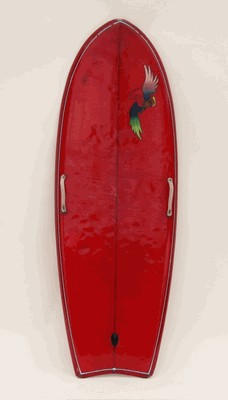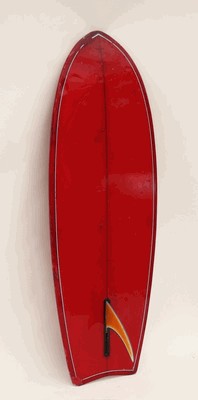Trevor Yamamoto Paipo Interview
December 4, 2009. San Francisco, California (USA)
Questions and e-Mail Interview by Bob Green & Kim Green
Photos courtesy of Trevor Yamamoto unless otherwise noted
(Click on pics for a larger image.)
1. In an e-mail posting you described seeing paipo riders around many spots on Oahu in the1980s. Where was being surfed?
My
family moved back to O`ahu in the late 1970’s, when I was still in
elementary school. Like a lot of kids back then, I started out at
Waikiki Wall / Graveyards & Kailua Shorebreak. There were still a
lot of paipo riders at the Wall/Graveyards, riding both Hawaiian style
plywood paipos & fiberglass El Paipo style boards. However, in
Hawai`i, we never thought of the El Paipo type board as a paipo; we
called them kneeboards. As my friends and I got a little older and
progressed a bit, we started going out to Publics & Cunhas;
Bomburas & Baby Haleiwa at Ala Moana Beach Park; then Sandys &
Makapu`u. There were quite a few paipo riders at all those spots up to
the start of the ‘80’s. By the time we started going to Country in the
early 1980s, the paipo had pretty much disappeared out there.
|
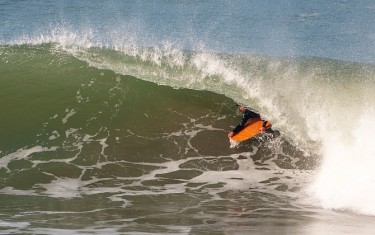
Trevor is "shaded"
|
2. How many paipo riders do you estimate were around then? Who were the hot paipo riders at that time?
I
couldn’t give you an estimate of the actual numbers of paipo riders
back then. Like I said, during that time period, paipo riders were
still a common sight at probably every break on O’ahu popular with
bodyboarders today. I’d say that at spots like the Wall & Makapu`u,
paipo riders could make up about 1/3 of the crowd in the outside line
up. The rest were boogies & bodysurfers. I didn’t know any of the
good paipo riders of the time very well. They were all older guys that
kind of intimidated us kids. We used to call them “da mokes”. They were
all cool though, just as long as you didn’t get in their way. In those
days, us kids learned a lot of our duck diving skills from trying to
avoid getting run over by the paipo guys as they came flying in from
the outside.
I remember one of the best guys who surfed Graveyards & Ala Mo had
a red El Paipo board. That board was 4’10” with a spoon deck and rope
handles at the nose and both rails (like the one shown below). He was
always getting the deepest barrels on that board. He let me check it
out a couple times, but he never let me ride it. I remember it so well
because I kept bugging my parents to buy me a board like that.
El Paipo Spoon Kneeboard. Dimensions: 5'2" x 21-1/2" x 3"
At Makapu’u, there were a bunch of good paipo riders. One guy from that
old group is still charging - I think his name is Harry. That dude
doesn't seem to age. Just a couple years ago, I went out at Makapu`u on
one of those days when the lifeguards "close" the beach. Harry was
still one of the few guys riding furthest outside. He’s been showing up
for all the good swells at Makapu`u
for decades. I think he was also the guy who told my friends & I
the story of how he and some other paipo riders scored rides from China
Walls all the way through Pillars back in the late-1960s. That’s a
good half-mile plus ride.
"Harry showing the young guns who still KING of the mountain! HLI sty"

Photo courtesy of: Darren K Akana.
See more pictures of Harry riding his paipo at Hawaiian Line International.
At Sandys, you’d see Royal and Primo Richards. Those guys ripped on the
paipo: prone, knee, and standup, connecting from Half Point through
Pipe Littles. I’ve heard that it was the Richards bros. who “invented”
the drop knee stance for the boogie board, not Jack Lindholm. (Trevor
says, "Here’s a brief account, don’t know the guy who wrote it, but
I’ve heard this story many times before: Woody's Surf Shop.")
Then there were the guys who made the transition from paipo to
bodyboards and became some of the first pro stars of bodyboarding –
Jack Lindholm, J.P. Patterson, and Pat Caldwell. The later 2 guys were
prone riders who rode paipo style on a bodyboard – hips forward – legs
lifted, inside hand back or in the face of the wave and outside hand
forward – opposite of most bodyboarders today. The bodyboard/surfing
media called it “wounded duck style”, but it was the same style most
paipo riders had been using for years. I used to see those guys ripping
Sandys, Makapu`u, Base (North Beach), and later Country when I was growing up on O`ahu.
Caldwell in action
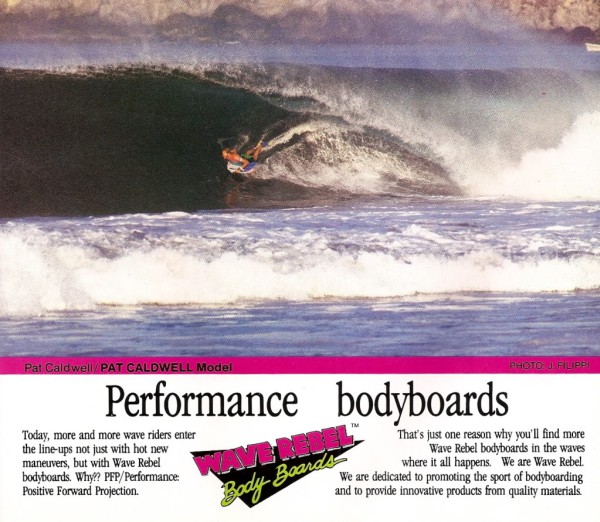
Photo courtesy of: http://i674.photobucket.com/albums/vv103/hyser99/Pat.jpg.
There was another pro big wave charger, Dan Kaimi, who probably started
on a paipo; but you didn’t really see the crossover style when he rode
his bodyboard like you did with Caldwell and Patterson. Those
bodyboarders were known more for big wave/big barrel charging, not
small wave tricks. That really impressed us as kids. Any of these guys
I mentioned would make a truly worthy paipo historical interview subject.
Boards from the 1980s
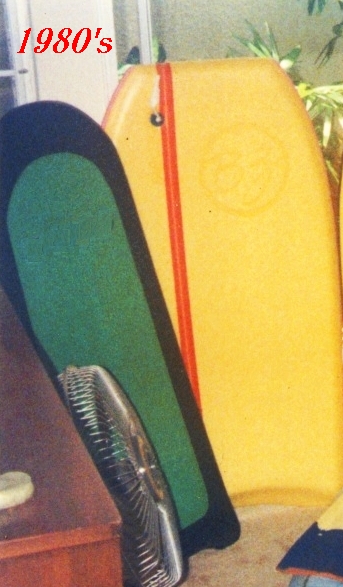
Photo courtesy of Trevor Yamamoto.
3. What was the approach to wave riding back then – tubes, speed or turns? Any kneelos or riders taking an alternative stance?
The
ply paipo vets in Town and at Makapu`u were into catching the set waves
furthest outside and going for flat out speed runs broken up with big
carving cutbacks, sometimes multiple hand drag spins, both prone and on
their knees. The guys on the
El Paipo style boards rode almost exclusively on the knee and were into
getting the deepest barrels. There were a couple guys who rode those
kneeboards stand up with (swim) fins like a short boarder. Then there
were a few guys like the Richards bros. who were really versatile going
for off the lip moves, spins, and barrels, either prone, kneeing or
stand-up.
4.
Many Hawaiians have described making paipo boards in shop at school.
How old were you when you made your first paipo? What was the
shape and dimensions of this board?
I
think I was around 13 yrs old when I made my first paipo in
intermediate school woodshop class. I used a piece of three-quarter
inch (3/4") mahogany plywood. That board was about 42” long (I used a
boogie board as a guide) and was a narrower version of the popular
guitar pick/ tear drop style shape, probably around 22”-23” across the
tail. Top and bottom were flat, no rocker at all. I remember wanting to
imitate the spoon/concave deck of the Paipo Nui/ HPD style board, but
nobody could show me exactly how to do it.
5. Was their much variety in the shapes made at the time?
The
most common shape back then was some variant of the guitar pick Paipo
Nui/ HPD (Hawaii Paipo Designs) style, made of plywood. There was a lot of variety in tail
shape: straight, rounded, vees, and crescents. Probably the second most
common shape was the tombstone/bullet shaped board, also with a variety
of tails. Then there was the style of board with the wide pointed nose
and a narrower rounded-, squared-, or vee-tail, usually with single or
twin fins. Sometimes you’d see some guy who put wings on this last
style of paipo like those on the surfboards of the period. You also had
some commercial El Paipos & Newport style boards, along with all
kinds of salvaged broken surfboards.
6. What were your flippers?
My
first pair of fins were blue & green Churchills purchased from the
original Hawaiian Island Creations shop across from the police station
in Kailua. Later I went with Churchill Makapu`us
and Vipers. I also used a lot of found and/or mismatched fin combos
(Churchills, Scott, Manta, Duckfeet) when I was kid. You were always
guaranteed to either lose a fin or find a fin if you surfed Sandy’s or
Makapu’u a lot.
|
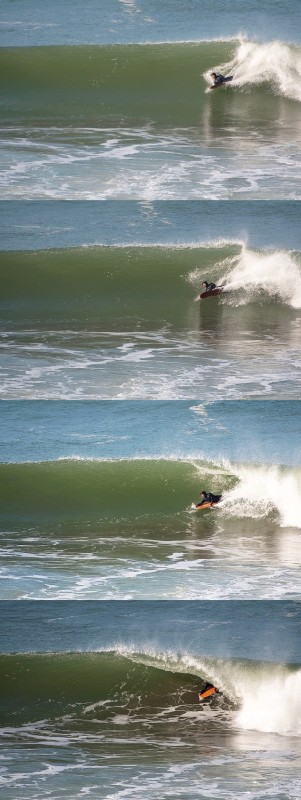
San Francisco Bay area sequence - Dec. 2009
|
7. Your father was a surfer. Have you heard many stories of paipo
riding in the 1940s-50s (types of boards ridden, who was
surfing and
where, were the boards called paipo or something else)?
Unfortunately,
I never heard many surfing stories from my father. He’s mentioned
riding surfboards, paipos and skimboards in Waikiki when he was growing
up. He also told me that Makapu`u
was really sharky back then. Not much more than that. He also never
mentioned any alternate names for a paipo, besides bellyboard, as far
as I recall. I guess he never became as passionate about surfing as I
did; he’s more of a fisherman. I’ve heard a lot more stories about
fishing in the “old days” than surfing. I’ll see my father over the
Christmas holidays, so I’ll be sure to ask him what he remembers about
paipos.
8. I’ve read that you were discouraged from surfing. Did that stop you?
Not
at all. Tell a young teenager he can’t do something he loves and of
course he’ll rebel and do it more. Thankfully, there was a good public
bus system on O’ahu that facilitated my surfing escapes. I had a youth
bus pass so I could get to school. That pass was good for unlimited bus
rides for the month, and could be used as easily for a ride to school
as a ride to Sandys. I’d stash my fins in my school bag and off I went.
Also, back in the late 1970s & early 1980s, it was the style in
Hawai’i to wear surf shorts as your every day street clothes, or under
your long pants like boxers, so I was always prepared for the water. My
parents were usually none the wiser. When I got to the beach I could
always bodysurf and I also had friends I could borrow a board from.
9. Any rides from those days on Oahu stand out?
Growing up on O`ahu,
there were so many good days and rides over the years it’s all kind of
a blur. From those early days when I was in intermediate school, I do
remember getting some super long rides on a paipo in Waikiki. Not the
epic Steamer Lane to Queens rides that the real old timers talk about;
but, more like outside Publics/Castles area all the way past Graveyards.
Still a pretty long ride, and a pretty good stoke when you’re a kid. I
went on to get many heavier/better rides in Hawai’i for sure, but those
were mostly on bodyboards when I was older.
10. After your shop board did you try out any other paipo boards?
When
I first started out, I had a Hawaiian neighbor who used to let me and
his 2 sons borrow his board occasionally. That board was glass over
plywood with an enormous single fin. I think the fin was chosen because
it happened to be lying around, not for functionality. The board had a
wide pointed nose, narrower squash tail and was less than 4 ft long.
When my neighbor’s sons and I rode that board, we always had a hard
time avoiding hitting that giant skeg on the bottom, and were terrified
of what would happen to us if we broke it off. That board was fast but
was impossible to turn by us kids; the older neighbor kid could knee
ride it though. One day I pulled into a close out barrel with that
board and it ended up flipping back into my face busting my mouth open
pretty bad. I never rode that board again after that. I also tried the
HPD type board a few times. That style board catches waves easily and
is super fast, but I never rode one long enough to get used to the
spoon deck or master any big moves with it. Then there was my friend’s
kickboard style “paipo.” This haole kid who went to my high school for
a year or two had this kickboard sized and roughly shaped piece of
plywood that he charged everything with. We couldn’t tell if that
“board” had ever been purposefully shaped or was just some piece of
debris that he found washed up on the beach. That board rode like a big
lunch tray, but it was so beat that you could get splinters in your
hands from using it. I also used my own “borrowed” McDonald’s trays and
larger cafeteria trays – never cared for those; lot’s of homemade
handboards – very partial to those; and finally the old Voit Freerider
kickboard thing. Poobah brought one of those down to Big Sur this past
July. That Voit board was fun, but it always felt like it was going to
break your wrists if you put both hands on the handle and pulled into
big Sandys close out barrels. 11.
Were any of the fiberglass bellyboards around then? Were you in Hawaii
when people started transitioning to bodyboards? How did that affect
the scene?
Like
I mentioned, there were a bunch of guys knee riding the El Paipo style
boards in Town, when I was a kid. We always considered those to be
kneeboards, not bellyboards or paipos. A paipo board to most people in
Hawaii is strictly a plywood homemade board, or the similarly shaped
commercial versions. Now that I think about it, I remember a few of the
short Newport style paipos around. Those were hard to distinguish from
guys riding salvaged broken surfboards. Those boards were definitely
not as popular as the ply paipos in Hawaii.
Yes, I witnessed the transition from paipos to bodyboards. When I first
started in Hawai’i, bodyboarders were already making up around one-third of
the outside line-up at places like Walls and Makapu`u.
The rest were bodysurfers and paipo riders, and they still dominated.
However, the inside line-up of spots like that were already starting to
get pretty packed with kids, all around my age or younger, on boogies.
I had an original Morey Boogie board, too, which I used until it broke.
After that, I went into my bodysurf/paipo board/borrow whatever board
phase, right up until the time the Mach 7 Boogie came out. As the
boogie kids grew older and got better, they began to steadily
infiltrate the outside line-ups and displace or compete with the
bodysurfers and paipo riders. Also, a lot of paipo riders started
converting over to bodyboards at this time, too; especially after the
slick bottom Mach 7 board came out, and later the hard bottom Turbos. I
had a friend whose father rode paipo and then converted to a Mach 7
with a custom single box skeg.
Prizes at the 1983 Makapu`u Bodysurfing Contest

Trevor believes that early HPD was the top prize for the boogie/paipo division.
Finally, no new generation of paipo
riders came up to replace the older guys who quit or converted to other
forms of riding. Growing up, I knew only one other kid close to my age
who continued riding a paipo after slick bottom bodyboards came out.
The rest of my friends & classmates who surfed committed to
bodyboards or shortboards, and had no interest in paipos even if they
had started on/knew how to ride one. Board surfing and bodyboarding
had all the appeal for kids - magazines, surf movies, contests,
pro stars, progressive moves, etc. In the short period from say 1977 to
1982, I could see paipo riders becoming a shrinking minority group in
the line up on O`ahu. The old time paipo guys still continued to make their presence felt on any good swell at Makapu`u throughout this time though. Also, I think I remember that the big bodysurfing contests at Makapu`u and Panics still had a paipo division up into the 1980s.
12. You bodysurfed, rode kneeboards and longboards as well as paipo. When did you stop riding paipo? Any particular reason?
By
the mid-1980s, I was hardly riding paipos anymore. Bodyboarding,
bodysurfing/handboarding, kneeboarding, and later, occasional
longboarding took precedence, and there wasn’t much room left for paipo
riding. I never completely gave it up while I was living in Hawai’i,
but I’d probably ride my paipo only a couple times a year towards the
end. There was definitely a lot of peer pressure that pushed kids like
me to become either a dedicated bodyboarder or short boarder back then
too. I stopped paipo riding completely when I moved from Hawai`i
to the U.S. East Coast in the mid-1990s. At that point in my life, I was
just bodyboarding and bodysurfing, occasionally longboarding. That
pattern continued when I moved to the west coast, with a little
kneeboarding thrown in the mix. I guess having the ability to take the
easy path and just buy a pre-made whatever kind of modern board
distracted me from getting back into paipo riding as an adult; until
this year.
13. When did you first think about riding paipo again? What sparked your interest?
Paipo
riding has always been in the back of my mind over the years. I talked
about making a paipo board years ago with a friend when I was living on
the East Coast. That friend started surfing in the 1960s and made his
own surfboards; he seemed into the idea. We never got around to that
project before I moved away though. When I traveled to Latin America to
surf, I always wondered why the local kids who couldn’t afford a
surfboard or bodyboard weren’t making their own paipos. When I moved to
NorCal and surfed various spots for the first time, one of my first
thoughts always was: “I wonder if people used to paipo board this
place?” Some of the waves up here seem ideal for the paipo. Finally,
motivation and opportunity came together this past summer and I finally
made/rode a paipo again. The whole alaia board revival/fad has
definitely revived interest in home built wooden boards in the surfing
community. There was a thread on a bodyboarding forum discussing making
prone alaia boards. The discussion first went into exotic woods and
glued up blanks. Then someone asked about using high grade plywood.
Later there was a sarcastic comment/suggestion to just use “knot
grade” plywood. That last comment got me laughing thinking about all
the paipos on O`ahu from years past that were actually constructed of
scrap generic plywood and ridden in solid waves. It just so happened
that I was in the process of replacing some weathered and warped
plywood shed doors at my house during this time, and a few days later I
was shaping a new homemade paipo out of one of those old doors.
|
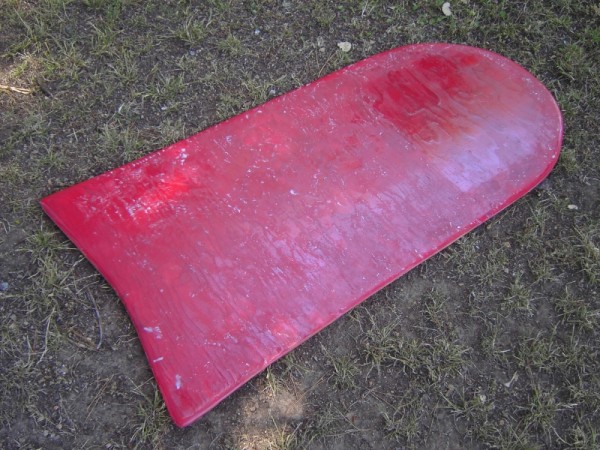 |
First Shed Door Ply Paipo Board Dimensions
Length: 43"
Width (nose): 19"
Width (mid-point): 19.75"
Width (tail): 21.75"
Thickness: 1/2''
Very subtle nose rocker and concave on the deck
Additional Comments:
I
removed a warped plywood shed door at my place and decided to make a
paipo. Shaped the rails and tail more bodyboard like than my old
paipos. Rushed the final sanding and threw on a coat of fast dry poly
on both sides, followed by a coat of red fast dry enamel on the deck
last. More flex than I remember for a paipo. I started with about a
1/2'' ply vs. the 3/4" ply I used back in the day. Flex worked in my
favor on the steep ones though. Definitely going to do more wood
shaping and riding in the future.
|
|
14. What was it like riding paipo again after not having ridden one for years?
I
picked it back up again pretty quickly. I blew my first two take off
attempts, but after that, it was all good. I’d say performance wise,
it’s probably better the second time around. Riding a more flexible
board than I did in my kid days, and being a full grown adult has
definitely opened up performance potential in ply paipos that I
couldn’t realize as a skinny kid on a stiff, heavy board. At least
initially, getting out to the lineup in decent sized waves on a paipo
wasn’t as effortless as I remember as kid though!
15. What sort of paipo do you ride now? What was your motivation behind the shed board door boards? How did they ride?
Right
now I’m riding another one-half inch thick recycled generic plywood paipo
(not an ex-shed door though!): 42” long and 22” across the shallow vee
tail. Basically a copy of the first board I made this past summer with
a slightly modified tail shape. I applied some epoxy to this board to
hopefully increase its longevity. I made this board in an afternoon,
threw on the epoxy and rode it the next day. Definitely a crude job
finish wise, but it rides just fine. It has a distressed/vintage look
to it though; fooled some people at the beach. Had a good test session
in clean hollow surf two weeks ago.
The whole alaia craze coupled with my lingering interest (in paipos)
was the motivation behind the shed door board. I’d hear all these
younger guys talking about the various aspects of alaia boards – shape,
rail design, exotic woods, gluing blanks, etc. It always seemed to me
that they were over complicating things and overlooking the proven wave
riding history of simple ply paipo boards. These guys didn’t seem to
realize that they could easily build a functional board from
potentially free common materials with just a few hours work; and that
they could do everything from proning big closeouts to stand-up rides
with that simple board if they had the motivation to give it a try. I
was staring at these unused pieces of ply in my yard and thought, "damn,
I’m going to show these kids a thing or two and have some nostalgic fun
doing it."
I was surprised at how well the first shed door board rode. Using
half-inch (1/2") thick ply instead of the old stand by three-quarter
inch (3/4") gave the "new" board a lot more flex then the old paipos I
used to ride. This
flex made for a really responsive board turning wise, and made it
surprisingly easy to ride in hollow waves. I was also surprised that I
could pull off (bodyboard style) off the lip forward spins and rollos
with the shed door. I was never able to do that as a kid on the old three-quarter inch (3/4") thick paipo. The new board also rode really well in the
barrel, even on closeouts. The drawback was with all the flex the
board sometimes felt as if it was going to snap in closeout barrels,
and it would get wet noodle wobbly if you happened to get caught behind
a decent sized close out section. That first board did eventually crack
early this fall while I was planing over a bumpy section at OB. I made
another board out of the second shed door too. This was more of an
experiment. The second board was almost 4-foot long and fish shaped. I put
some rocker in that board using hot water. I intended to put twin fins
on this thing and try for more knee rides or stand ups. However, I
never put the skegs on and took the board out for a couple test runs.
The second board was fast, but definitely not as maneuverable as the
first board. It seemed less flexible, but I ended up snapping that
board almost clean through after only three sessions with it. The short
lifespan of my half-inch (1/2") thick boards clearly shows why the old timers
all went with three-quarter inch (3/4") thick wood in Hawai’i. I was able to knee ride
both boards, and they seemed to work ok. Never pulled off any stand ups
though.
|
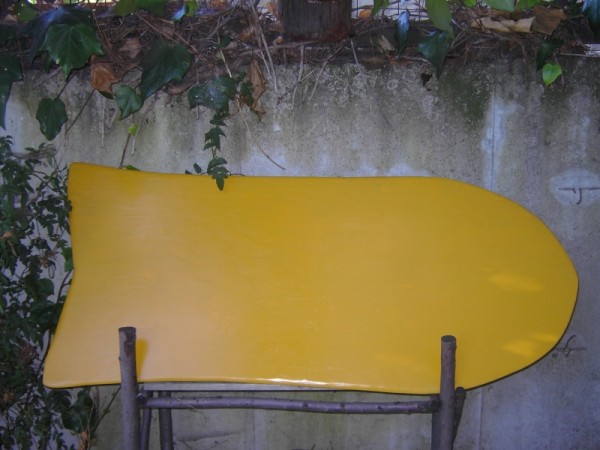 |
Shed Door #2 Dimensions
Length: 47"
Width (nose): 19.5"
Width (mid-point): 18.5"
Width (tail): 22"
Thickness: 1/2''
Additional Comments:
Thought
my shed door ply paipo was missing its other half, so I made this snack
food inspired board. This board was made of recycled generic ply and had a little extra nose rocker on it.
|
|
16. Any thoughts on what design features make a paipo ride well?
My
experiences with the half-inch (1/2") thick shed door boards has me completely
sold on flex, something I totally overlooked as kid. Back in the day,
everyone was using three-quarter inch (3/4") ply for their paipos in Hawai’i, and I did
the same. That thickness of wood was great for durability, but those
old boards didn’t seem to flex at all; especially with a skinny kid on
top, not a 250 lb moke. I remember my old three-quarter inch (3/4") board was fast, but
it was hard to turn quickly and hard to ride hollow beach break waves
with. My flexible half-inch (1/2") thick paipo reacts a lot quicker to direction
changes and gives you a lot more control on steep drops, and in the
barrel. The performance of a real flexible paipo seems much more
bodyboard like when it comes to maneuvers, but you still retain the
paipo wave catching ability and planing speed. I felt kind of silly
realizing (after doing some ‘net searching) that many prior generations
of folks had already thoroughly developed, experimented with, and
applied the whole flex concept in all kinds of paipos over the years.
Unfortunately, that bit of wisdom didn’t get passed down to me when I
was young. Now I have to figure out how to make a flexible and durable
ply paipo. I love the way my thinner more flexible ply boards ride, but
they’re failing on me in typical Norcal beach break. I’d like to hear
from those who have undoubtedly been down this road before.
The other thing that seems to work for me on a ply paipo is fairly
sharp edged upswept rails that become sharper and more skeg like at the
corners of the tail. Seems to hold the wave face really well and
control side slipping.
Riding the ply paipo in Northern California during Winter 2009/2010
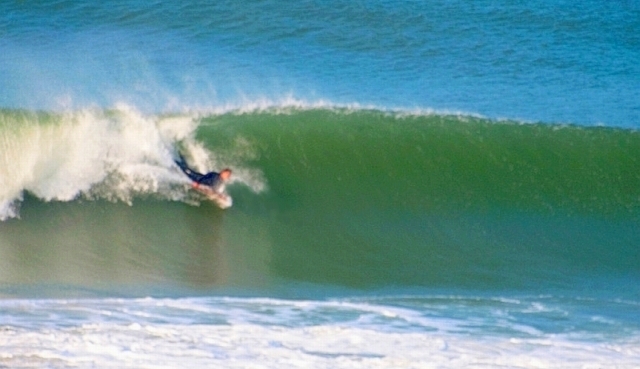
17. How does riding a paipo differ from to the other craft that you have ridden?
The
things that stand out most about riding a ply paipo are the tremendous
amount of performance, versatility, and stoke you can get out of one in
comparison to the extreme simplicity and low cost of its design and
construction. No other kind of wave riding craft can compare with it on
that basis.
I don’t know of any other wave riding craft out there that you can say
has wave catching ability like a longboard, with equal or greater down
the line speed; can be ridden in both super heavy or super mellow
conditions; is good in the barrel and on the open face; can be ridden
prone, kneeling or standing up; and can be constructed in a few hours
with simple tools from free or cheap, mostly natural materials.
18. Do you see any other paipo riders around?
I
rarely see other paipo riders in the San Francisco area, where I’ve
been living and surfing for many years now. There’s an older white
bearded guy I’ve seen occasionally at OB over the years who rides prone
on an El Paipo style board. Once, I saw a guy out at Sloat on a black
HPD with a leash. I remember paddling over and briefly talking with
him. Was that you Kage? When I go back to O`ahu, there are still 2 or 3 of the old time paipo riders who I’ll always see out at Makapu`u
when it’s good. I saw a guy out at Pipe on a paipo a couple years ago.
When I was longboarding Queens last year, I saw a paipo boarder out
near Wall/Graveyards. I’m sure there’s still a regular old time paipo
crew there.
19.
Do you approach riding a paipo differently now? You are closest
to Ocean Beach in SF -- is that a good wave for paipo?
After
being off the paipo and riding a bodyboard for so many years, my first
instinct now is to ride my paipo like I’m on a bodyboard. I have to
make a conscious effort to ride old skool traditional paipo style - one
hand on the rail, no hands, etc. Both styles have their pros and cons,
but it’s all good fun. Taking a fresh look at paipos after many years,
I think there’s a bunch more performance I can get out of these things
now that wasn’t possible as a kid – so it’s a new challenge for me.
Definitely a more economical and line-up friendly diversion than
taking up SUP’ing, or something like that. The DIY stoke of building
and riding a homemade paipo definitely has a lot more appeal for me now
too. Is it back to the roots nostalgia as I get older, or just getting
caught up in the build your own board fad? I don’t know.
Ocean Beach in SF can be really good for a lot of things, including riding paipo, if you can deal with the paddle out - sshhhh.
Bonus Photographs: See a series of photographs
of Trevor riding his paipo in the NorCal surf. Photos were shot by a
fried of Trevor's with no experience shooting surf pics... not a bad
job by both of them! Below are pictures of the board.
|
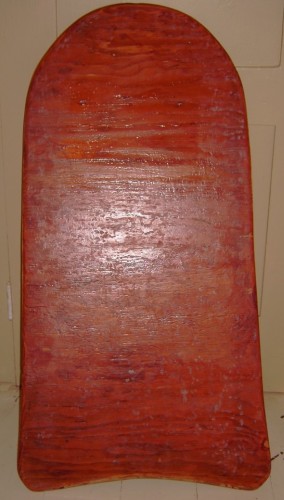 |
My Current Paipo Board
My
current paipo (board in the pics) is similar to the original red shed
door, but with the tail corners rounded to loosen up the board. It also
has 2 coats of marine epoxy (no glass) for strength. Been riding it
fairly regularly this winter - so far so good.
Trevor Yamamoto
Feb. 10, 2010
|
|
|

